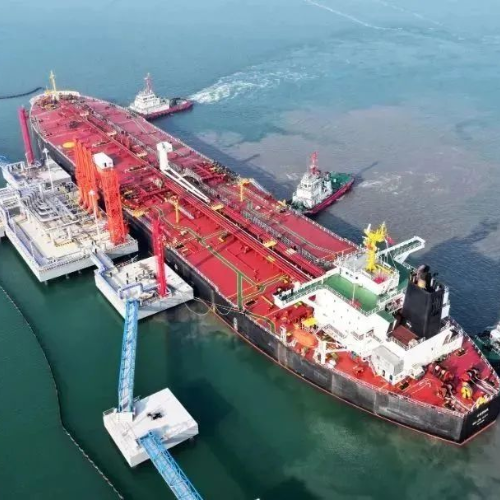The world of global trade is often complicated, and sometimes countries take actions to avoid the rules set by others. This is what seems to be happening at Dongying port in China, where tankers carrying oil from countries under US sanctions have been unloading their shipments. These actions are raising alarms, as they appear to be a way to bypass sanctions that aim to stop certain countries from selling oil to global markets. Recently, there have been reports of sanctioned tankers calling at Dongying, highlighting how this port could be playing a critical role in helping these ships avoid international restrictions.
A Hidden Gateway for Sanctioned Oil Shipments
Dongying, a port located in Shandong province of China, has recently attracted attention for a troubling reason. Tankers that have been sanctioned by the United States for carrying oil from Iran and Russia are docking there to unload their cargo. For years, the US has imposed sanctions on countries like Iran and Russia to limit their ability to sell oil to other countries. However, despite these sanctions, oil from these countries continues to flow, often through complex routes and secretive practices.
The first sign of this growing trend was when a tanker named Amil made its way to Dongying. The Amil is a vessel that was sanctioned by the US in late 2024 for transporting Iranian oil. According to tracking data, the ship discharged around 252,300 barrels of Iranian oil at Wantong Liquid Chemical Terminal in Dongying, between February 11 and 14, 2025. This terminal is controlled by a private company, Shandong Wantong Petrochemical Group, which has made efforts to distance itself from public scrutiny.
Crippling Sanctions: Russia’s Oil Transport Crisis Worsens
The Amil tanker had a history of evading detection. For months, it stopped transmitting its location data, a tactic often used by vessels to hide their movements. It was only after sailing through the Singapore Strait in January 2025 that the ship’s tracking signals were turned back on. It then headed for Dongying, where it unloaded its cargo. This is significant because it suggests that this port has become a key location where sanctioned oil from Iran can enter China without raising too much attention.
Russian Oil Makes Its Way Through Dongying Port
The Amil tanker was not the only sanctioned vessel recently found unloading oil at Dongying. Another tanker, the SI He, also called at a different terminal in the port, unloading a large shipment of Russian oil. The SI He, which was sanctioned by the US in January 2025, had been carrying 702,200 barrels of Russian crude oil. It picked up its cargo from Kozmino, a Russian port, and made its way to Dongying’s Baogang Crude Oil Terminal.
What is striking about the SI He’s visit is that it also marks a significant violation of US sanctions. The US has placed these sanctions on numerous vessels to prevent the flow of oil from Russia, especially after Russia’s actions on the global stage. The SI He’s visit to Dongying highlights how even US restrictions are not enough to stop the flow of Russian oil to China. Additionally, reports confirm that the Baogang terminal is privately owned, making it less accountable to the state-run Shandong Port Group, which oversees most of the local port operations. This suggests that the port’s facilities are being used in ways that bypass international rules and regulations.
A Pattern of Sanctioned Tankers in China
The occurrence of sanctioned tankers unloading oil at Dongying port is not an isolated incident. In fact, it is part of a larger trend of vessels from countries like Russia and Iran continuing to supply China with oil, despite the restrictions placed by the United States. Another tanker, the Nikolay Zadornov, a Russian-owned vessel, discharged 700,000 barrels of Russian oil at Zhoushan port in China in mid-February 2025. Like the SI He, this tanker had been sanctioned by the US, but that did not stop it from offloading its cargo in China.
US Sanctions Shake India Russia Iran Oil Trade Amid Growing Tensions
The receiving terminal at Zhoushan, privately operated by Yangshan Shengang International Petroleum Terminal, has also been involved in receiving oil from US-sanctioned ships. This indicates that a pattern is emerging where Chinese ports, often privately owned terminals, are becoming key players in facilitating the transfer of sanctioned oil from Russia and Iran to Chinese refineries. This presents a clear challenge for the US, which aims to limit the economic support these countries can get by cutting off their access to the global oil market.
Despite the increased efforts by the US to enforce sanctions and prevent the transportation of Iranian and Russian oil, these tankers are finding new ways to deliver their cargo. The recent surge in sanctioned vessels calling at ports in China underlines how global trade routes are adapting and evolving to find loopholes around international laws.
The situation at Dongying and other ports in China highlights the growing importance of private terminals in the world of oil trade. These facilities offer more flexibility and can operate outside the reach of government-imposed regulations, allowing for the continued flow of oil from countries under sanctions. As a result, China remains an important destination for oil shipments from Iran and Russia, despite the growing pressure from the United States to stop these imports.


